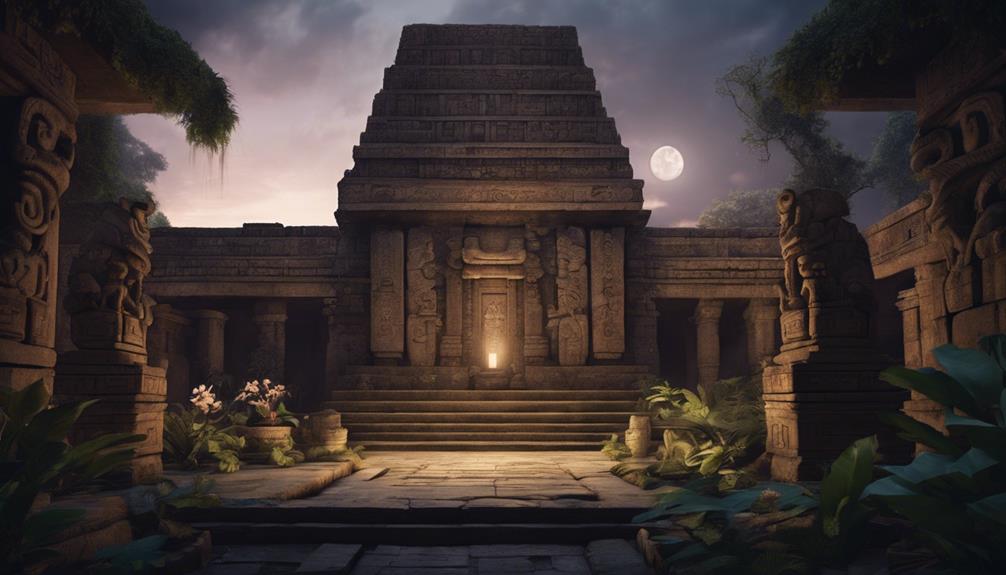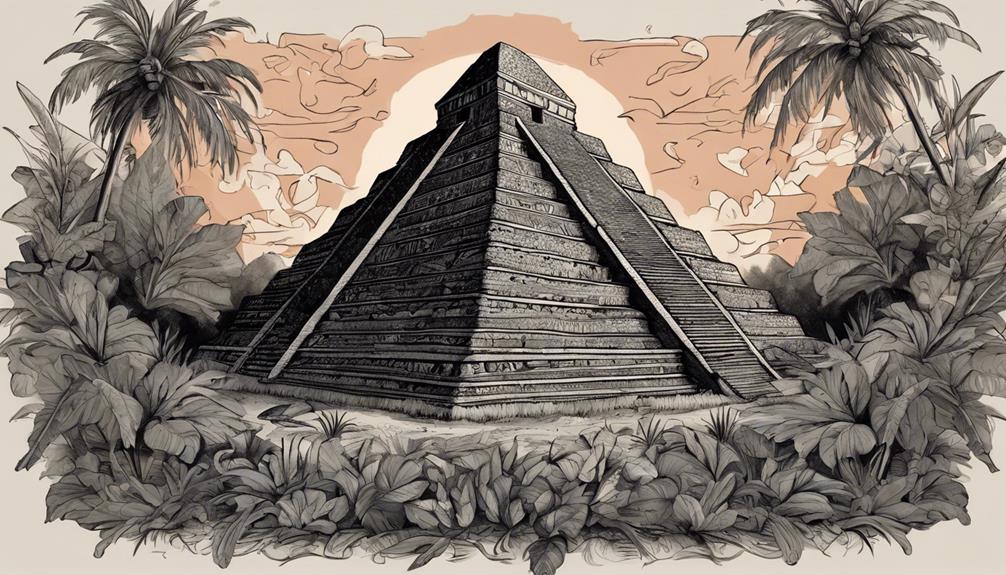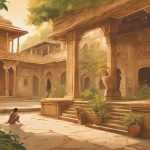You stand at the threshold of a rich cultural heritage, where the poetic tradition of the Aztec Empire unfolds in the majestic language of Nahuatl, revered as the 'language of the gods' for its spiritual potency and divine linguistics. Nahuatl poetry employs syllable rhythm, repetitive phrases, and anaphora to convey sacred narratives and myths of Aztec cosmology. Poems reflect the empire's contradictions of love and war, juxtaposing tender expressions of love with vivid descriptions of battle. As you enter this domain, you'll discover a profound commentary on the human condition, and the intricate symbols and metaphors will reveal the Aztecs' profound understanding of the natural world, inviting you to explore further into the depths of this ancient literary culture.
The Language of the Gods

As you explore the domain of Nahuatl poetry, you'll discover that the Aztecs revered their language as 'the language of the gods,' a designation that underscores the sacred importance they attributed to this sophisticated tongue. This reverence is rooted in the Aztecs' belief that their language was a divine gift, imbued with spiritual potency. As a result, they developed a system of divine linguistics, where language was seen as a powerful tool for communicating with the divine. The sacred scripts, adorned with intricate symbols and hieroglyphs, were considered a bridge between the mortal and divine spheres. These scripts were not merely a means of recording events, but a way to convey the sacred narratives and myths that underpinned Aztec cosmology. The Aztecs' reverence for their language is a confirmation of the significance they placed on the power of language to shape reality and connect with the divine. As you explore further into Nahuatl poetry, you'll uncover the intricate ways in which language was woven into the fabric of Aztec spirituality.
Poetic Forms and Structures

Exploring the sacred scripts as a bridge between the mortal and divine spheres, you'll now find that Nahuatl poetry's intricate forms and structures were carefully crafted to convey the rich cultural heritage and spiritual narratives of the Aztec Empire. These forms and structures were designed to evoke a sense of reverence and connection to the divine, as well as to convey the complexities of human experience. You'll notice that Nahuatl poetry often employs a distinct syllable rhythm, which adds to the overall poetic cadence and creates a sense of musicality. This rhythmic quality is particularly evident in the use of repetitive phrases, refrains, and anaphora, which serve to emphasize key themes and ideas. Moreover, the use of metaphor, allegory, and symbolism adds depth and complexity to the poetry, allowing for multiple layers of interpretation. As you explore further into Nahuatl poetry, you'll discover a rich tapestry of forms and structures that reflect the Aztecs' deep connection to their cultural and spiritual heritage.
Themes of Love and War

During the Aztec Empire's tumultuous reign, Nahuatl poetry's exploration of love and war themes served as a poignant reflection of the empire's own contradictions, where the beauty of romantic love and the brutality of war coexisted in a delicate balance. As you explore the poetry, you'll discover how the Aztecs navigated this paradox, often juxtaposing tender expressions of love with vivid descriptions of battle. This dichotomy was reflective of the empire's own struggle to maintain cosmic balance, where the pursuit of Imperial pride and dominance was tempered by the need for harmony and balance in the universe. The poets' exploration of love and war reveals a deeper understanding of the human experience, where the desire for connection and the drive for power are intertwined. Through their poetry, the Aztecs not only reflected their own contradictions but also offered a profound commentary on the human condition.
Aztec Poets and Their Works

While delving into the rich literary heritage of the Aztec Empire, you'll encounter a diverse array of poets whose works not only showcase their mastery of the Nahuatl language but also offer a glimpse into the complexities of Aztec society. These poets, often trained as Aztec scribes, were well-versed in the intricacies of Nahuatl poetry and its various forms. Under Imperial patronage, they crafted works that reflected the empire's values and ideals. You'll notice that many of these poets drew inspiration from the natural world, using imagery and allegory to convey moral and philosophical themes. Notable poets like Nezahualcóyotl, a ruler-poet, and Tecayehuatzin, a noble poet, exemplify the sophisticated literary culture of the Aztecs. Their works, often written in the ornate and expressive style characteristic of Nahuatl poetry, provide a unique window into the Aztec worldview. As you explore the works of these poets, you'll gain a deeper understanding of the Aztec Empire's cultural and intellectual achievements.
Symbolism and Metaphor

How do the intricate symbols and metaphors woven throughout Nahuatl poetry reveal the Aztec's profound understanding of the natural world and its intricate relationships with human existence? As you explore the rich tapestry of Nahuatl poetry, you'll uncover a world where cosmic imagery and ritualistic allegory converge. The Aztecs saw the natural world as an extension of their own existence, where the cycles of nature mirrored the cycles of human life. In their poetry, you'll find metaphors that liken the human heart to a blooming flower, symbolizing growth and transformation. The Aztecs also employed ritualistic allegory to convey the interconnectedness of all living things, illustrating the delicate balance between humanity and the natural world. Through these symbolic representations, the Aztecs demonstrated a profound understanding of the intricate web of life, where every thread – human, animal, and natural – is intertwined. As you investigate Nahuatl poetry, you'll uncover a profound appreciation for the beauty and complexity of the natural world.
Frequently Asked Questions
What Was the Social Status of Aztec Poets in Their Society?
As you explore the world of Aztec poetry, you'll discover that poets held a revered position in their society. They were esteemed as keepers of cultural heritage, and their poetic prestige was unmatched. As literary elites, they enjoyed a privileged status, often serving as advisors to rulers and chroniclers of history. Their verses were highly valued, and their skills were sought after by the elite.
How Did the Spanish Conquest Impact Nahuatl Poetry?
As you explore the aftermath of the Spanish Conquest, you'll find that it had a profound impact on Nahuatl poetry. The cultural suppression that followed the Conquest led to a significant decline in the production and preservation of Nahuatl poetry. Many indigenous texts were destroyed, and the native population was forced to adopt European customs and language, further eroding the traditional poetic forms.
Were Aztec Poems Meant to Be Recited or Sung?
You're about to uncover a hidden world of performance modes, where Aztec poems weren't just mere words on a page, but a symphony of vocal inflections, tone, and gesture. Imagine a world where poets were rockstars, and their words could conjure emotions, evoke the gods, and stir the soul. The truth is, these poems were meant to be performed, not just read silently. You'll find that the ancient Aztecs used vocal inflections, body language, and dramatic pauses to bring their poetry to life.
Did Nahuatl Poetry Influence Other Mesoamerican Cultures?
As you explore the reach of Nahuatl poetry, you'll find that its influence extends beyond the Aztec Empire. The Maya civilization, in particular, borrowed from Nahuatl poetic traditions, incorporating them into their own cultural practices. This regional diffusion of poetic styles is a testimony to the power of Nahuatl poetry, which spread throughout Mesoamerica, leaving an indelible mark on the literary traditions of neighboring cultures.
Are There Any Surviving Nahuatl Poetry Manuscripts From the Aztecs?
You may have heard the theory that the Spanish conquest of the Aztecs led to the destruction of all Pre-Columbian manuscripts, a notion that evokes a sense of loss and cultural erasure. While it's true that many Lost codices were indeed destroyed, you'll be relieved to know that some Nahuatl poetry manuscripts from the Aztecs have survived. These rare, fragile artifacts remain a tribute to the rich cultural heritage of the Aztecs, offering a glimpse into their poetic traditions and artistic expression.


